Two reliefs and a statuette
London, Science Museum
The objects form part of the Wellcome Collection of Medical Objects and are on permanent loan to the museum from the Wellcome Trust. The two reliefs were registered as objects 17 and 18 in 1936, the statuette as object 23 in 1936. All three were said to be from Ostia. The objects were purchased in Rome in 1932 by Captain Peter Johnstone-Saint, a collector working for Sir Henry Wellcome.
Marble relief with a parturition scene
A woman lying on a bed, giving birth to two or perhaps three children. She is assisted by three women. It is noteworthy that the woman giving birth is lying down. It has been said that in antiquity women gave birth only in a seated position (cf. a relief in the facade of tomb 100 of the Isola Sacra necropolis). However, in the early second century AD Soranus of Ephesus mentions the "general rule that extraction of the fetus in difficult labor must take place with the woman lying down" (Gynecology book II, translation Temkin, p. 72).
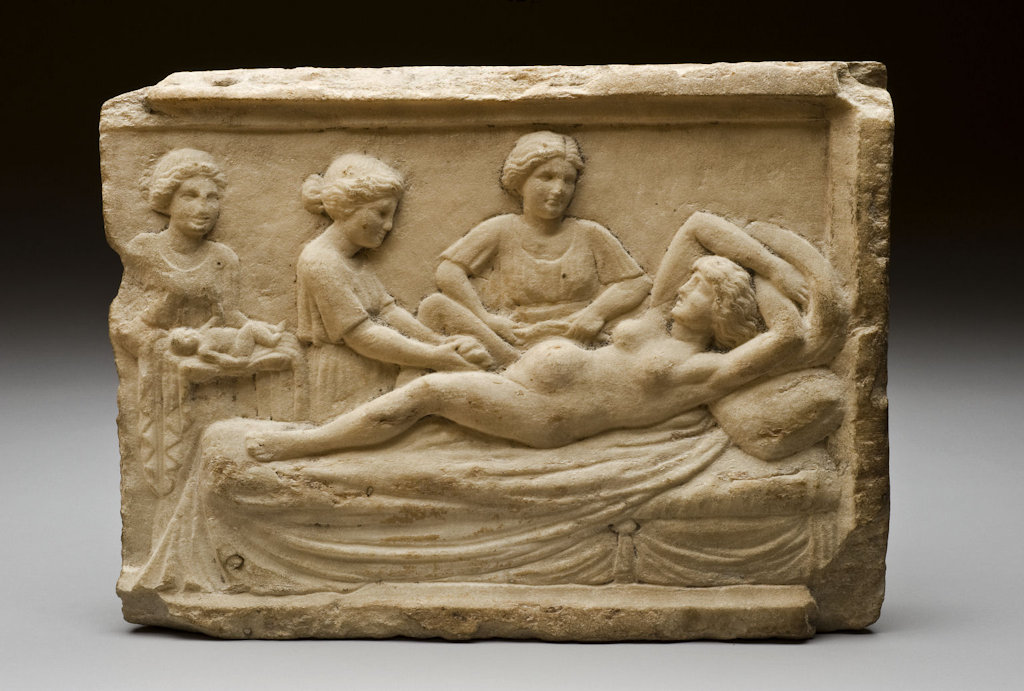
Click on the image to enlarge.
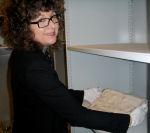
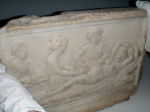
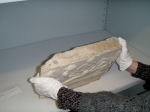
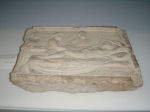
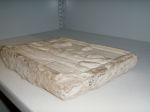
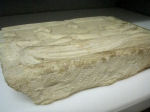
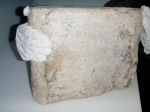
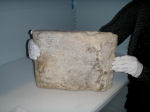
Click on the images to enlarge. Photos: Caroline Lawrence.
Inv. nr. A129245, reg. nr. 17/1936. Small to Medium Object Store. H. 0.25, w. 0.34, th. 0.063. In the upper side are a round hole and a rectangular depression. On some of the photographs traces of paint seem visible on the relief. Wellcome Museum catalogue card.
Marble relief of a mother nursing her child on a bed
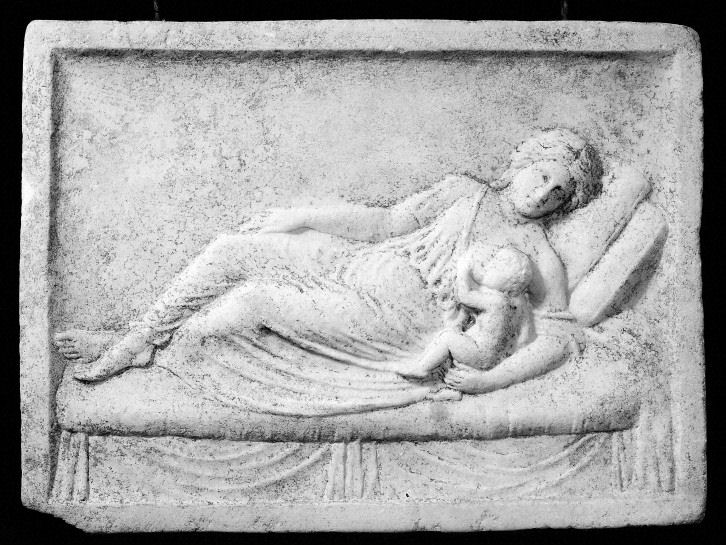
Inv. nr. A129246, reg. nr. 18/1936. Small to Medium Object Store. H. 0.255, w. 0.338, th. 0.049. Wellcome Museum catalogue card
Marble statuette of Hygieia
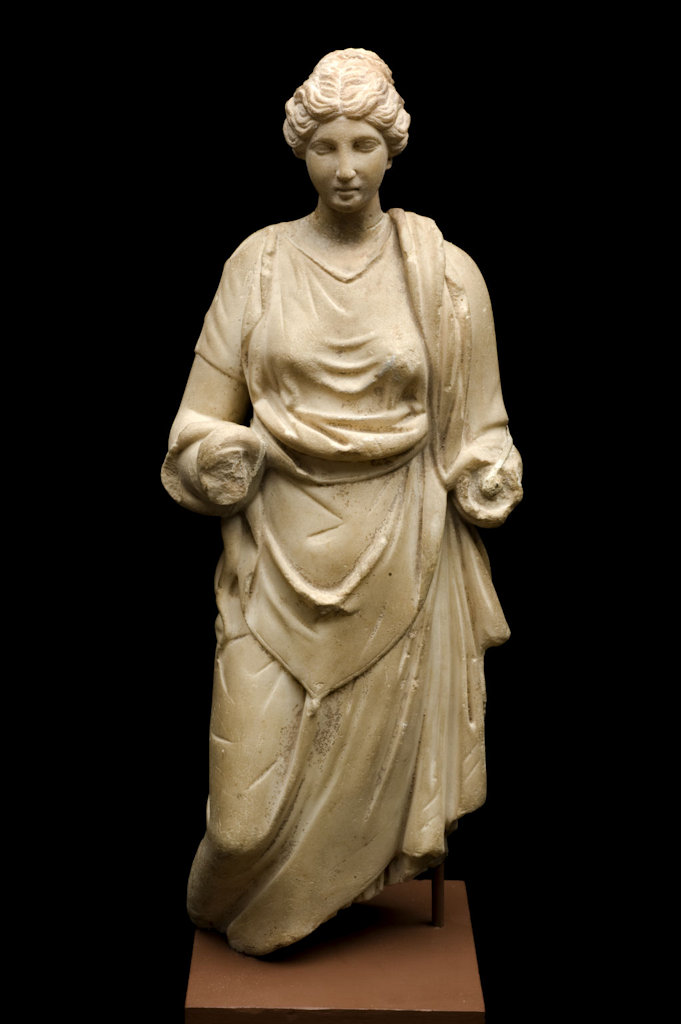
Click on the image to enlarge.
Inv. nr. A113241, reg. nr. 23/1936. Science & Art of Medicine Gallery. H. 0.392. Wellcome Museum catalogue card.
Notes on Mariano Rocchi
by Antonia Arnoldus-Huyzendveld, 27 March 2012
On the three catalogue cards a name can be read in relation to the purchase: Racchi, Rocci and Rocchi. This may well be Mariano Rocchi (Perugia 1855 - Roma 1943). He was one of the most significant art collectors and dealers of his era. He had moved to Rome from Perugia in 1907. His collection was on the first floor of Via Nazionale 243.
In reference to the sculpted slabs from Ostia, I went to the Max Planck library in Florence, where a book about Rocchi by Chiara Silvestrini is available: Mariano Rocchi antiquario - il commercio d'arte sull'asse Perugia-Roma tra Otto e Novecento, Perugia 2008. The first thing I checked was the long list of items in Rocchi's Collection of Objects of Art and Antiquities, published in 1912. At the time those objects were showcased in his house in Rome. Silvestrini acquired the probably only preserved copy of this small volume through a US seller. The list is indicative of the wide range of interest of Mariano Rocchi. There are 803 pieces and groups of pieces in the collection, grouped as: pictures - paintings on glass - carved and engraved wood - artistic marble and iron work - glass and crystal work - ancient porcelain and majolica - bronzes - ironwork - ivories, fans and marbles - silver plate - jewellery - cloths - laces - engraved stones, pastes and bronze. The only entry potentially interesting here is number 740: "two hundred and fifty engraved stones, of Greek, Roman and Etruscan period". There is no direct reference to a "sculpted slab". And nowhere in the book is there a direct reference to Ostia.
But he had evidently good relations with the fascist regime (which promoted the Ostia excavations), and also with the UK. The first link is proven by his important contribution to the "Mostra d'Arte Retrospettiva" in 1911 (Castel Sant'Angelo, Rome), which was part of the preparations for Mussolini's expositions. His contacts in the UK started during art expositions in the last decades of the 19th century, after which he became a friend and advisor of Sir Frederich Leighton, who collected items for the National Gallery of London and later became president of the Royal Academy. Rocchi advised him mainly about the acquisition of Renaissance objects from central Italy. Around 1912 Rocchi has made several offers to the Victoria and Albert Museum ("una ricca collezione in vendita"), but officially the museum was never interested. The correspondence is preserved in the archives of the museum and reported by Silvestrini.
Mariano Rocchi originally was a painter, and not a bad one to judge from some works reproduced in the book. He was born in 1855 in Perugia, where he worked as a painter, restorer and painting teacher. A first known scandal that involved him was about frescos he had personally detached from the inside of a house in Perugia in 1894, and in the sale of which he was the intermediary. A certain Pulszky, a nobleman and director of the Art Gallery of Budapest, was the intended buyer. At the end, between hidden addresses, bureaucratic slowness and diplomatic fears the frescos ended up anyhow in the Art Gallery of Budapest, where they still are. The strategy of Pulszky was: "The first six months of the year tended to be used for tracking down works, whereas in the second six months, in summer, and autumn, he realized his purchases, each time with the help of professional Italian dealers". Mariano Rocchi, at the time still in Perugia, was one of them.
All in all, he sold 30 items to the museum, which allowed him to buy his house-shop-museum in Rome. But from that moment on the "Ufficio Regionale per i Monumenti" kept an eye on him. It seems that his operations in the art commerce were not directly against the law, though the event was enough to force him from his position as a teacher. His name appears only twice in the inventory of robberies and sales attempts of the superintendence of Umbria, and towards the end of the century he even enjoyed a certain social prestige. Silvestrini says: "Protected by the current legislation, and probably by cunning political support, he became ever more a full time professional art dealer". He sold items in Italy and Europe, and after the start of WW I in the US. In the twenties of the 20th century Rocchi was enlisted in the official register of the antiquarians of Rome. For eventual future reference, in 1924 there were also: Addeo, Barsanti, Bulgari, Corvisieri, Della Torre, Fiorentini, Giacomini, Gorga, Jandolo, Rovelli, Sangiorgi and Sestieri.
He remained active as an art dealer until 1940. Rocchi's speciality was cloths, in particular the medieval tissues from Umbria called "tovaglie perugine", of which he had about 300 items, and on which he wrote a book in 1932. The Victoria and Albert Museum of London possesses a discrete number of them. Some info from their website: "Tovaglia is usually translated as tablecloth, and tovagliolo as napkin, but their use was in both ecclesiastical and secular contexts. Their function included napkin and table cover, as well as altar cloth and sacristy hand towel". About the export of art objects from Italy: the law of 1909 requested an export tax, which in 1920 was only 10% and later increased even up to 35%. The law of 1939 on the protection of the historical heritage officially made an end to all this. Silvestrini cites Carlo Aru, who illustrates in 1938 one of the classical ways to export art objects without paying the due export taxes: "In the hold of the ship, in the bodywork of a car or in the cabin of the plane, the smugglers carry a mediocre female portrait, which, once the license is obtained, is replaced with that authentic portrait of a lady by Titian".
Mariano Rocchi was evidently a merchant with the skills, the financial resources and the network to operate on the international market. Even if we hadn't known his name, he would have been our best candidate for obtaining and exporting in 1932 the Ostia slabs to the UK.